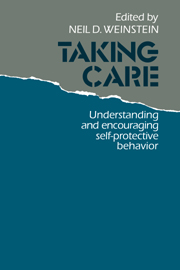Book contents
- Frontmatter
- Contents
- List of contributors
- Acknowledgments
- Introduction: studying self-protective behavior
- I Theoretical perspectives
- II Research and prevention programs for specific hazards
- 6 Why people take precautions against health risks
- 7 Community studies of smoking cessation
- 8 Preventing adolescent smoking
- 9 Natural hazards and precautionary behavior
- 10 Programs that encourage the adoption of precautions against natural hazards: review and evaluation
- 11 Why people take precautions against crime: a review of the literature on individual and collective responses to crime
- 12 Promoting citizen involvement in crime prevention and control
- 13 Injury prevention: limits to self-protective behavior
- 14 Perspectives on protective behaviors and work place hazards
- III Conclusion
- Index
9 - Natural hazards and precautionary behavior
Published online by Cambridge University Press: 03 February 2010
- Frontmatter
- Contents
- List of contributors
- Acknowledgments
- Introduction: studying self-protective behavior
- I Theoretical perspectives
- II Research and prevention programs for specific hazards
- 6 Why people take precautions against health risks
- 7 Community studies of smoking cessation
- 8 Preventing adolescent smoking
- 9 Natural hazards and precautionary behavior
- 10 Programs that encourage the adoption of precautions against natural hazards: review and evaluation
- 11 Why people take precautions against crime: a review of the literature on individual and collective responses to crime
- 12 Promoting citizen involvement in crime prevention and control
- 13 Injury prevention: limits to self-protective behavior
- 14 Perspectives on protective behaviors and work place hazards
- III Conclusion
- Index
Summary
Introduction
Efforts to determine how people deal with natural disaster began more than half a century ago. Researchers have examined a wide range of geological and climatological events, including hurricanes, earthquakes, tornadoes, tsunamis (tidal waves), and volcanoes. Early studies (e.g., Kutak, 1938; Prasad, 1935; Prince, 1920) focused on the responses of individuals and communities during and after a disaster, a type of natural hazards study that has become known as disaster research. Explanations of disaster responses have been based on theories of collective behavior and theories of social organization and disorganization (Dynes, 1970). Summaries of this research are available (Fritz, 1961, 1968; Mileti, Drabek, & Haas, 1975; Quarantelli & Dynces, 1977).
A second research tradition places emphasis on human precautions, actions taken to reduce the risk of future natural hazards rather than actions that are a response to an experienced disaster. Such “natural hazards research” began with work (White, 1945) that investigated why some precautions were taken more frequently than others and why losses seemed to be on the rise despite attempts to encourage protective actions (White, Burton, & Kates, 1958). A number of theorists have attempted to identify the mechanisms that lead people to take precautions (Burton, 1962; Kates, 1962; Simon, 1956; White, 1964).
The difference between disaster research and natural hazards research is mainly a matter of emphasis. In this chapter we seek to answer the question of what leads people to take precautions against natural hazards.
- Type
- Chapter
- Information
- Taking CareUnderstanding and Encouraging Self-Protective Behavior, pp. 189 - 207Publisher: Cambridge University PressPrint publication year: 1987
- 32
- Cited by



